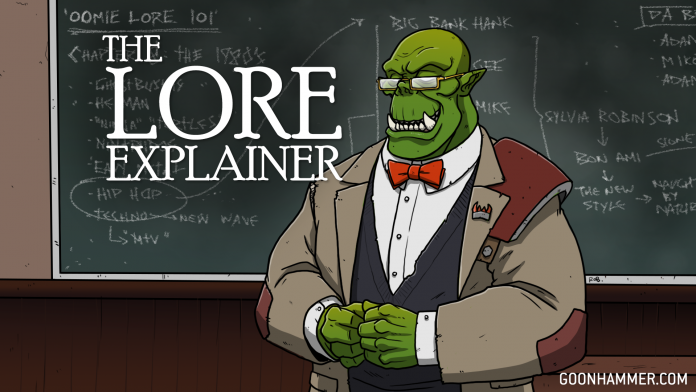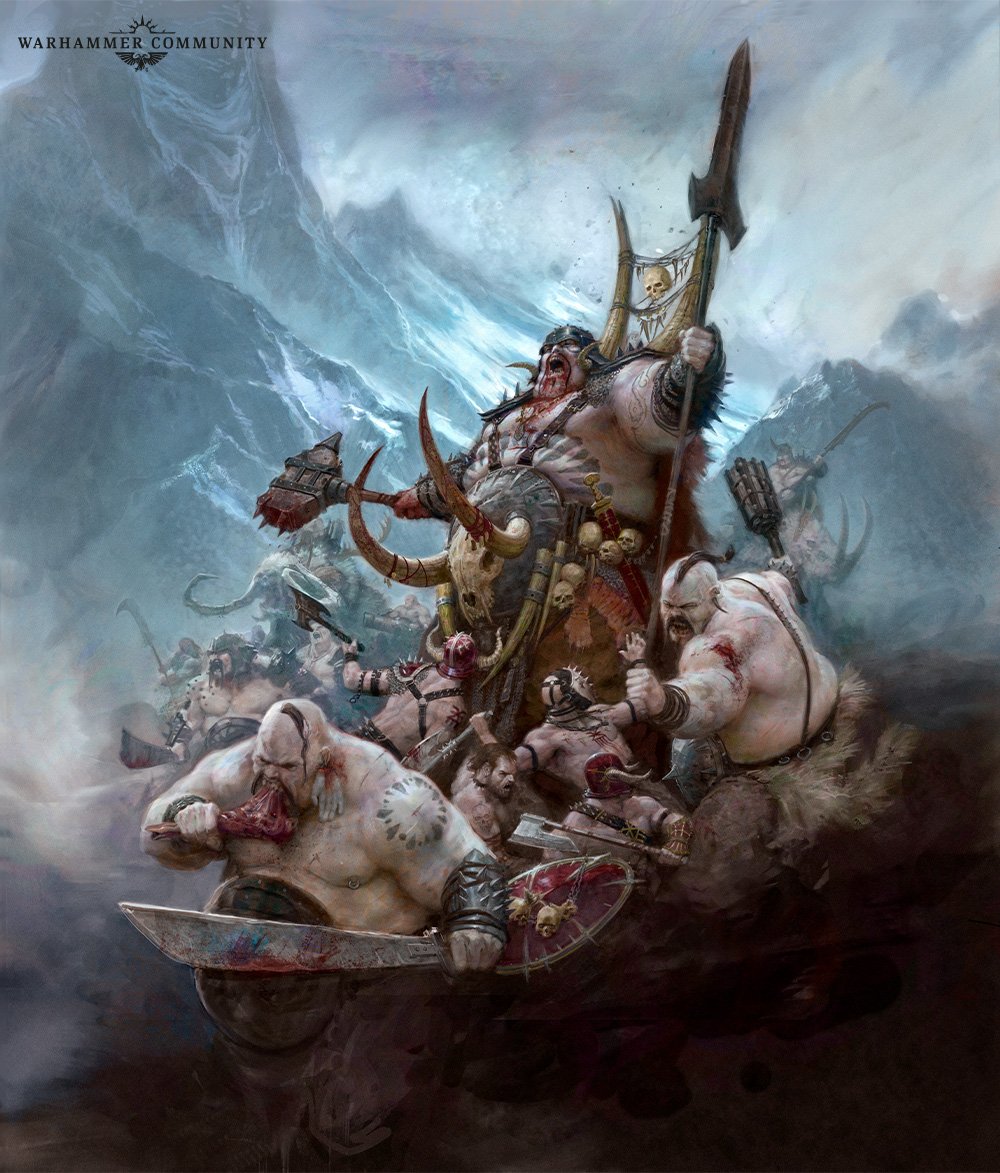
In this life, there are a great many pleasures, but what are the most essential? The urges that truly make us who we are? Yeah, you’ve got your Hedonites of Slaanesh engaging in all that decadent perfumery and getting down to business, but on the other side of that indulgent coin we find the subjects of today’s Lore Explainer, the consumers, the children of the Gulping God – The Ogor Mawtribes.
First things first; despite appearances Ogors are not simply oversized humans. They’re not even related to humans but are humanoids with a radically different physiology, adapted to their harsh lives and ways of war. An Ogor typically stands anywhere from ten to twelve feet tall, with truly incredible layers of fat and muscle making them appear even vaster still. Even the mightiest Ironjawz Orruk is a pipsqueak compared to a runt of Ogorkind. Coupled with this monstrous blubber and muscle, an Ogor’s vital internal organs are concentrated in their belly, chief of which is their Gut. An Ogor’s gut is truly a wonder of biological machinery, with powerful muscles capable of grinding and digesting just about anything, even the bones of the dead are food for an Ogor.
![]() Naturally, Ogors place a great deal of import on their gastric functions, and so the one (and often only) piece of armour that every individual wears is a large circular metal plate, affixed over the belly with a leather belt, known as a Gutplate. Ogors often don’t bother with armour besides this gutplate; after all, their very skin is like an armour, a dense, thick hide over a gambeson of fat and muscle. Sartorially-minded members of the tribe even decorate their bodies simply by jamming bones, tusks, or meat hooks straight through their skin. Such extraordinary resilience allows Ogors to operate in every environment of the Mortal Realms wearing nothing thicker than a pair of trousers (even Ogors have some concept of modesty, it seems) and effortlessly shrug off blows that would be terminal to lesser, weedier species. The elite of the Ogor fighting strength, hand-chosen by their Tyrant, do wear patchy makeshift armour, cobbled together haphazardly from plates of metal and the captured shields of fallen foes. Woe betide any foe that finds himself in front of a Tyrant’s Ironguts. So essential are these crack troops that a Tyrant will often hold them back until the arrival of the decisive moment, when a well-timed charge from these devastating killers will turn the tide and deliver victory for the tribe. Ogors can be heard to say that such a moment of reversal is “down to the Ironguts”.
Naturally, Ogors place a great deal of import on their gastric functions, and so the one (and often only) piece of armour that every individual wears is a large circular metal plate, affixed over the belly with a leather belt, known as a Gutplate. Ogors often don’t bother with armour besides this gutplate; after all, their very skin is like an armour, a dense, thick hide over a gambeson of fat and muscle. Sartorially-minded members of the tribe even decorate their bodies simply by jamming bones, tusks, or meat hooks straight through their skin. Such extraordinary resilience allows Ogors to operate in every environment of the Mortal Realms wearing nothing thicker than a pair of trousers (even Ogors have some concept of modesty, it seems) and effortlessly shrug off blows that would be terminal to lesser, weedier species. The elite of the Ogor fighting strength, hand-chosen by their Tyrant, do wear patchy makeshift armour, cobbled together haphazardly from plates of metal and the captured shields of fallen foes. Woe betide any foe that finds himself in front of a Tyrant’s Ironguts. So essential are these crack troops that a Tyrant will often hold them back until the arrival of the decisive moment, when a well-timed charge from these devastating killers will turn the tide and deliver victory for the tribe. Ogors can be heard to say that such a moment of reversal is “down to the Ironguts”.
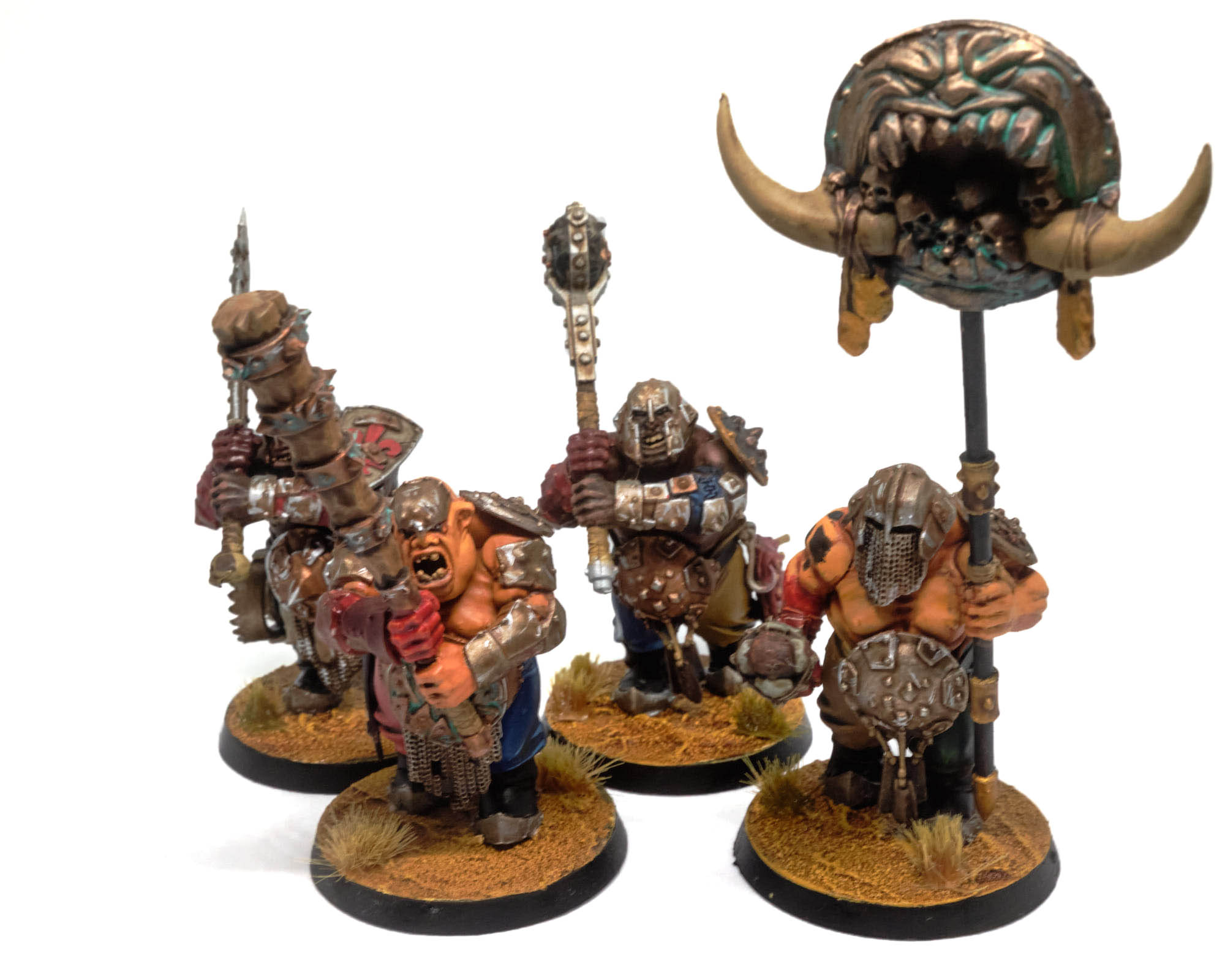
The defining aspect of the Ogor psyche is hunger, a constant all-encompassing desire to be eating something right now. No matter how much an Ogor stuffs into its mouth, there’s always room for seconds. This driving hunger and complete disinterest in things as wussy as “agriculture” pushes Ogor tribes into nomadic wanderings called Mawpaths. Imagine a swarm of locusts, only each individual locust is 12 feet tall, weighs as much as a Transit Van, and a hit from your flyswatter only makes it laugh. Each tribe sweeps through new lands and consumes everything its path, leaving only bloodstains and ruins in its wake. In this sense, the Mawtribe is very similar to British people on holiday (I’m allowed to say that, because I am, for my sins, a Briton).
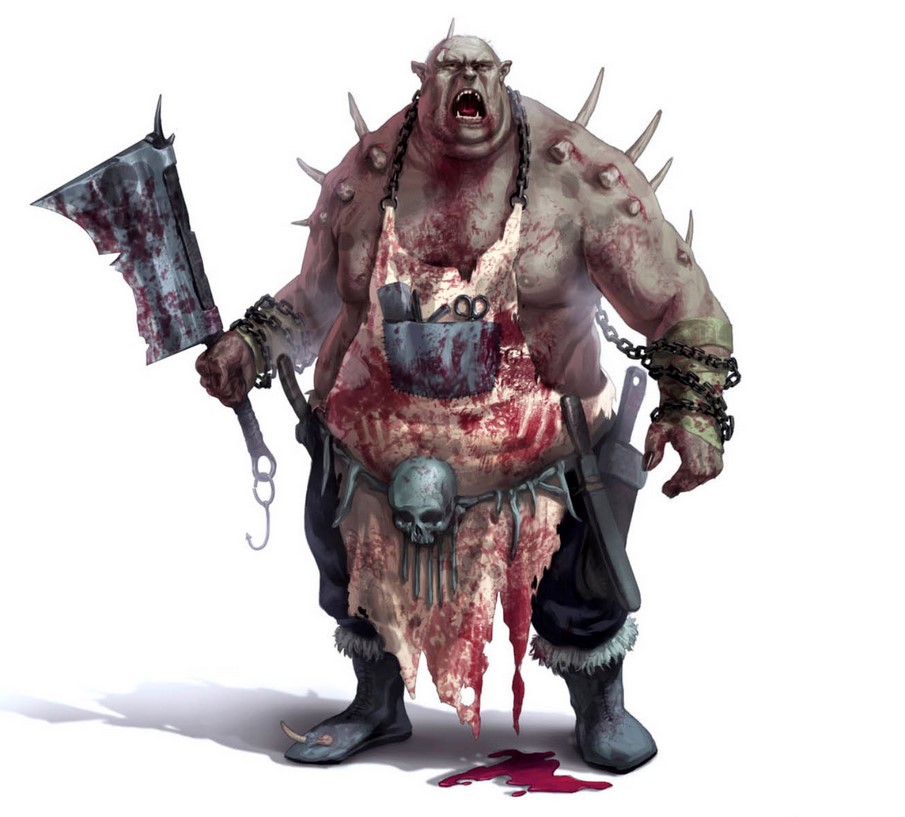
It’s no surprise that in the face of this hunger, the Ogors worship an aspect of Gorkamorka that they call “The Gulping God,” a divine creation of insatiable voracity, often represented in their imagery by a circle with sharp teeth. As you can imagine, Ogor society revolves around cooking, eating, and finding more things to cook and eat, for although Ogors will eat their food raw in the heat of the moment, they prefer food that’s been prepared and cooked by one of the tribe’s Butchers. Butchery for Ogors is less of a mundane mechanical process and more of a sacral communion with the divine (and it just tastes better with a bit of salt and pepper, y’know). Eating is a religion and Butchers are the clergy, their close connection to the Gulping God granting them potent magical abilities akin to those of a human wizard. Shower the enemy in great globs of boiling fat? No problem.
The great stewpots of the Ogors heave with bubbling broths containing all manner of ingredients, bird, beast, plant, fungus, intelligent species, skeleton? It doesn’t matter – everything is edible if you cook it for long enough. In this sense, Butchers are spiritually the same as your friend who swears that eating his 48 hour slow cooked beef brisket is like reaching out to touch the face of God, although in reality it’s more a sort of “Hunter’s Pot Perpetual Stew cooked in a vat the size of an above-ground swimming pool” kind of scenario.
The Butchers also direct the marching of the Mawtribe by acting as Haruspices, studying the entrails of slain foes in search of symbols indicating the guidance of the Great Maw. God only knows how “BBQ that way” ended up written on that guy’s small intestine, but hey, the Gulper gulps in mysterious ways.
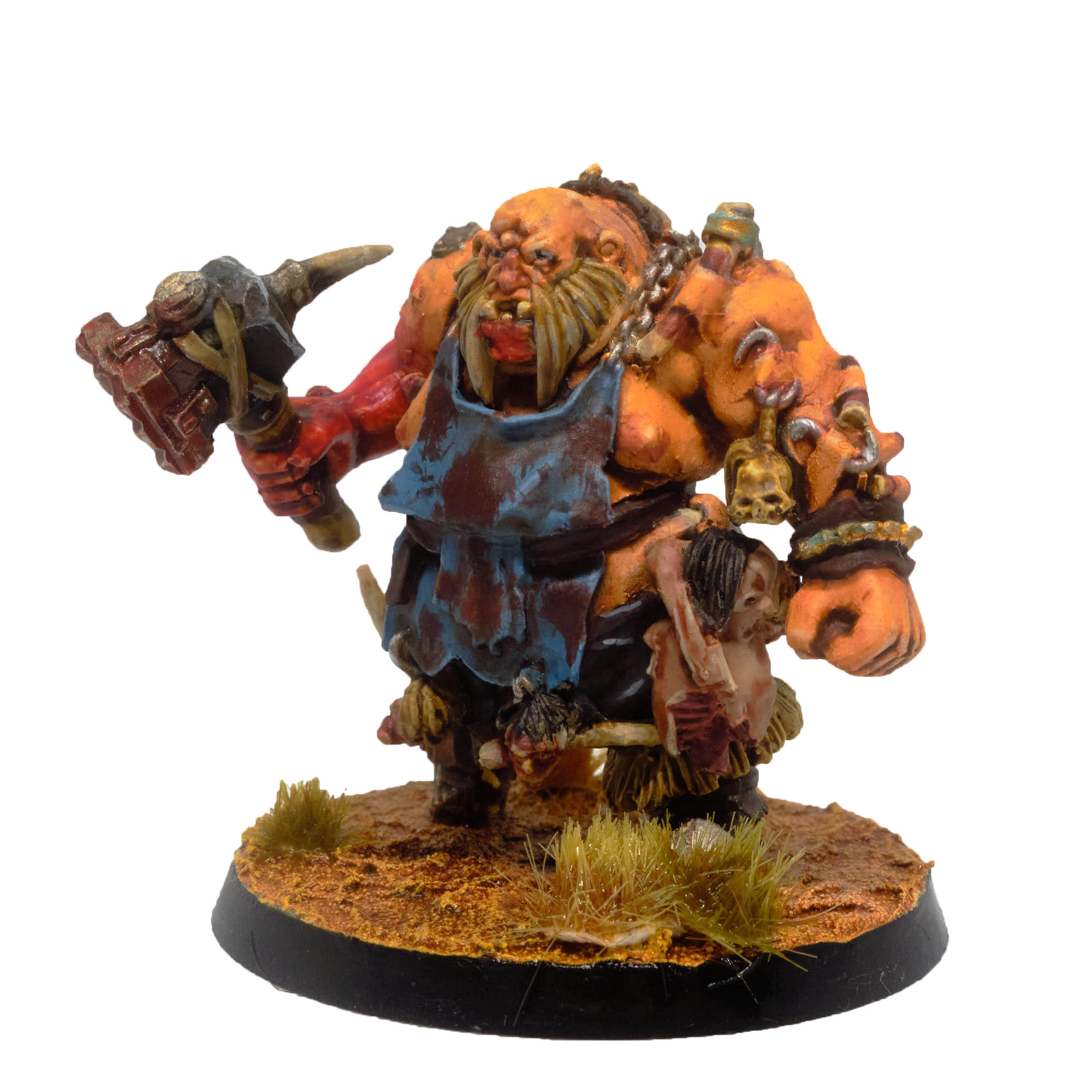
A Butcher who really has what it takes to bring home the bacon might swell to truly enormous proportions, undergoing a truly monstrous transformation to reach a meaty apotheosis, no longer a mere Butcher, the Ogor becomes a Slaughtermaster, at once a personal chef for the Tyrant, a high priest, and a living incarnation of the Gulping God’s endless hunger. A Slaughtermaster may hack off his own hands and replace them with wicked curved cleaver blades and, using chains hooks that fasten to his thick hide, drag behind him a huge cauldron as he wades into battle. A true gourmand, the Slaughtermaster seeks and chops off the choicest parts of the foe and tosses them into this great cookpot, all the while Gnoblar attendants stir the stew and gingerly transport it to the mouth of their master. Ogors take the maxim “You are what you eat” quite seriously, and as such, when a Slaughtermaster eats the flesh of something particularly strong or powerful, all the Ogors of the tribe may find that they are able to move quicker, that their muscles have expanded still further, or that their skin has become as tough as the hide of a Godbeast.
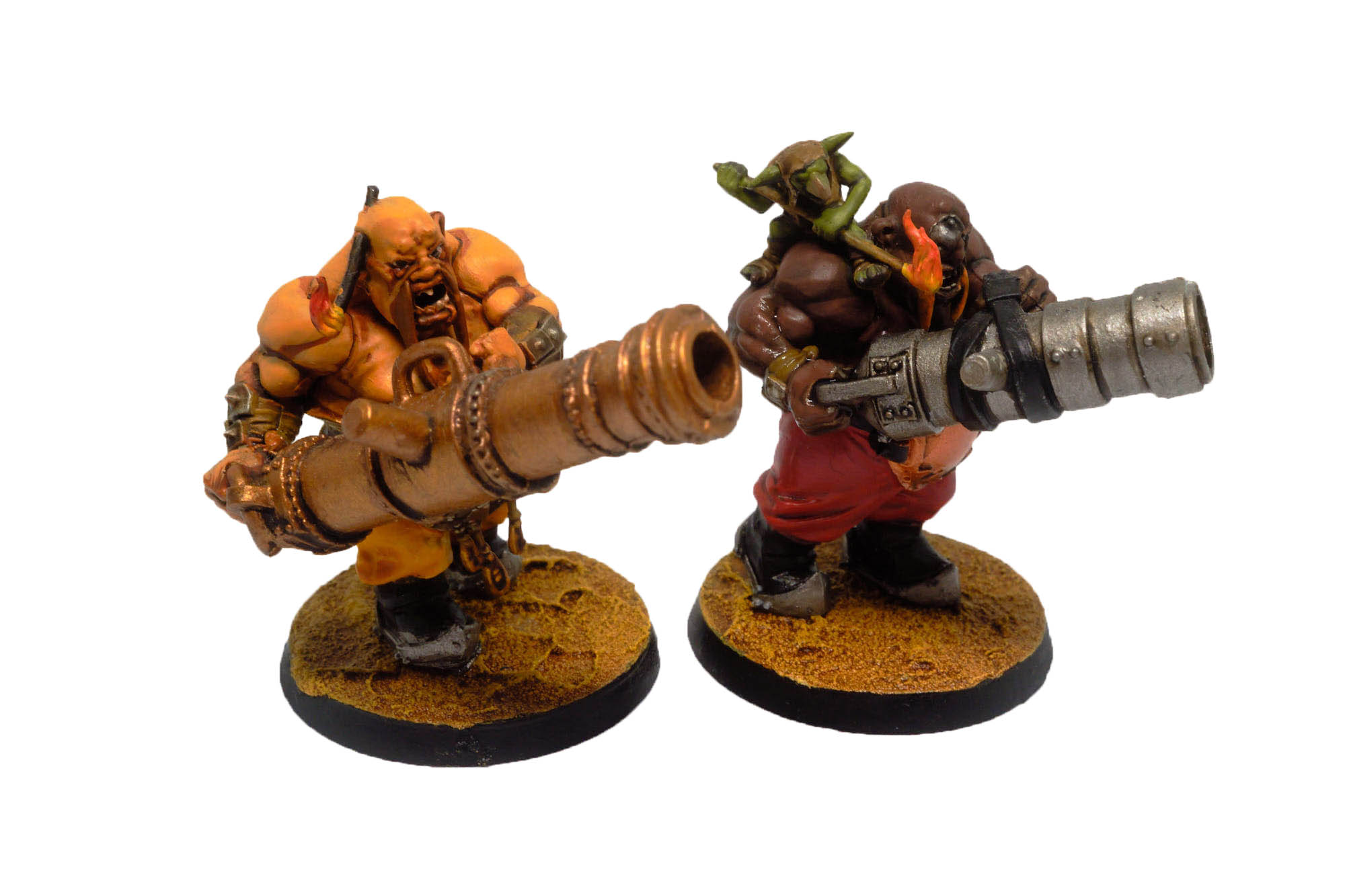
Some Ogors eschew the simple bludgeoning and slicing of their comrades, preferring to make use of more sophisticated weaponry and the use of Blackpowder. Delighted by the sound and sight of explosions, these individuals stride into battle, their skin covered in burn scars, toting the great cannons of the lesser races as though they were mere handguns, stuffed with shrapnel, discarded weaponry too small for the Ogors to use, and all manner of other junk. They are the Leadbelchers, and as you can imagine, a fusillade from their fearsome firearms is enough to turn a unit of ordinary humans into a pile of pre-chopped meat. Besides, should the enemy get too close, a cannon makes for a great bludgeon.
But these lumbering lardbellies are only half of the Ogre-picture – the Gutbusters, another facet of Ogre culture involves the taming and riding of massive beasts. These Ogres – the Beastclaw Raiders are both the victims and beneficiaries of a terrible curse that hounds them through the mortal realms. The Everwinter.
What’s an Everwinter? Well, put in the simplest way possible, it’s a sort of magic roving blizzard that chases the Alfrostuns of the Beastclaw Raiders around, with such intense fury and power that the Ogres are compelled to a harsh, nomadic life as they run ahead of the storm in perpetuity. The tribe has to flee before the Everwinter, for if it subsumes them, the Ogres will freeze solid, unable to move and critically unable to feed themselves. The thickness of their hides prevents them from dying quickly, and so a slow, agonising, starvation awaits any Ogres who find themselves caught by the rage of the storm.
In their flight from the storm, the Beastclaw Raiders have tamed and ride beasts as diverse as Mournfangs, Stonehorns, and Thundertusks. The smallest of these, the Mournfang, is an enormous lumbering beast that’s a mix between a Rhino and a Sabretooth Tiger, Ogre outriders atop Mournfangs speed across the battlefield and smash enemy lines to splinters like living battering rams, hacking foes to pieces with giant halberds, smashing them with great man-sized clubs, or shooting them with pistols the size of a person. The other beasts are more lumbering in nature, fantastical versions of the Woolly Mammoths of our own world. These gargantuan beasts are ridden by the Frostlords and Huskard Priests of the Beastclaw tribes, or by teams of Ogre riders armed with chain traps and mighty crossbows. To find yourself before one of these howling, stamping creatures is to face the full fury of the blizzard, as Thundertusks breathe torrents of freezing cold from their mouths and Stonehorns pulverise and chomp man, beast, and machine as they ride.
(Of course, in Warhammer Fantasy, this blizzard conceit didn’t yet exist, being created in the early days of Age of Sigmar when factions were somewhat blurry and, for example, there were about 12 different elf factions. The Gutbuster side of the army went away and then came back later, and as such the Mawtribes forces are a little mismatched in their theming. Lorewise, Gutbuster and Beastclaw don’t seem to have much to do with one another.)
So there you have it, the biggest, hungriest boys and girls in the Mortal Realms (well, with the exception of those lunkheaded stompy giants, of course) cut a bloody delicious swathe through the mortal realms either in their search for the tastiest morsels, or their endless flight from a horrific magic cursed snowstorm. Whatever their motivation, you really don’t want to find yourself in the way when the avalanche of flab and muscle comes.
Have any questions or feedback? Drop us a note in the comments below or email us at contact@goonhammer.com.
